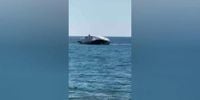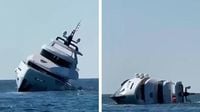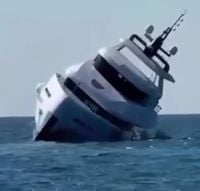On a sunny afternoon in northern Turkey’s Eregli district, what should have been a celebration of craftsmanship and luxury turned into a scene of chaos and disbelief. The Dolce Vento, a brand-new luxury yacht valued at nearly $1 million, met a watery fate just 15 minutes into its maiden voyage on September 2, 2025. Eyewitnesses and viral videos captured the dramatic moment as the 24-metre (approximately 85 to 100 feet) vessel tipped, took on water, and ultimately sank off the coast of Zonguldak, leaving its owner, captain, and two crew members scrambling for safety.
According to BOAT International, the incident unfolded at around 2:30 PM local time, right at the yard’s own facilities. The Dolce Vento, whose name means “sweet wind,” had just been delivered from Istanbul the day prior and was making its first-ever journey under its new owner’s watchful eye. The vessel’s construction had been completed at the Med Yilmaz Shipyard after five months of intensive work, boasting a steel hull and aluminium superstructure—a combination meant to promise both strength and elegance.
But elegance quickly gave way to panic. Amateur video, widely shared across social media platforms and reported by the New York Post and Hindustan Times, shows the yacht easing into the water before suddenly listing to one side. Within minutes, the Dolce Vento began to sway ominously, prompting the four people on board—owner, captain, and two crew members—to seek refuge on the vessel’s side. As the situation deteriorated, all four jumped overboard and swam for shore. Miraculously, no injuries were reported. The Turkish Coast Guard and port teams responded rapidly, establishing a security perimeter and dispatching medical personnel, as confirmed by NDTV and Fox News.
The spectacle didn’t end in the water. As news of the sinking broke, a video of the incident went viral, sparking a flurry of online commentary. Social media users expressed a mix of shock, humor, and skepticism. One quipped, “Seems like a really expensive way to test life jackets,” while another asked pointedly, “Who tf launches a yacht like this from the shore with wood planks?” Still others speculated about the vessel’s stability and construction costs, with one user remarking, “If a yacht that size only cost $1M, then that explains why it sunk.” The incident became not just a local tragedy, but an international talking point about engineering, luxury, and the unpredictable nature of the sea.
Behind the viral moment, however, were serious questions about what went wrong. Shipyard officials quickly announced that the cause of the sinking was under investigation, and that technical inspections would be carried out on the submerged vessel. Initial speculation, as reported by UNN and Mirror, centered on the possibility of excessive weight from above, which could have compromised the yacht’s metacentric height—a critical factor in maritime stability. In layman’s terms, the yacht may have been top-heavy, making it prone to capsizing even under normal conditions.
Experts in ship design echoed these concerns. Proper weight distribution and meticulous stability calculations are essential before any vessel is launched, let alone one of this size and value. The suspected stabilisation issue, highlighted by BOAT International and referenced in multiple reports, could have been a fatal oversight. The Dolce Vento’s rapid descent to a depth of seven metres underscored just how quickly things can go wrong when balance is overlooked.
While the technical investigation continues, the story of the Dolce Vento has already left an indelible mark on the maritime community and beyond. The yacht’s sinking was not the only recent incident to raise eyebrows: just last month, a fishing boat with 11 passengers began sinking off Pier 1 in Sheepshead Bay, Brooklyn, requiring a swift rescue by the NYPD Harbor Unit, as noted by Hindustan Times. Such events serve as stark reminders of the risks inherent in seafaring, no matter the vessel’s size or price tag.
The Dolce Vento itself was a symbol of ambition and luxury. Measuring between 85 and 100 feet in length, with a reported gross tonnage of 160 GT, the yacht was designed to offer both comfort and performance. Its journey from the Med Yilmaz Shipyard in Ereğli to its ill-fated launch was supposed to mark the beginning of a new chapter for its owner. Instead, the scene of the owner swimming to shore—caught on camera and broadcast around the world—became an instant viral sensation, a modern parable about hubris and the power of the elements.
For the Med Yilmaz Shipyard, the sinking is both a reputational and financial blow. The shipyard, which had completed the vessel after months of work, now faces scrutiny over its design and construction processes. Shipyard officials, as quoted in multiple reports, have committed to a thorough investigation, promising to uncover the root cause and prevent future mishaps.
The Turkish Coast Guard’s rapid response was lauded by observers, ensuring that the human cost of the disaster remained minimal. Their efforts, alongside those of the port teams and medical personnel, were instrumental in averting tragedy. Still, the image of a million-dollar yacht slipping beneath the waves just minutes after launch is not one that will fade quickly from public memory.
As the investigation unfolds, the maritime world watches closely. Was this a freak accident, a design flaw, or a preventable oversight? The answer will have implications not only for the Dolce Vento’s owner and builders but for yacht designers and enthusiasts everywhere. In the meantime, the wreck of the Dolce Vento rests seven metres below the surface, a silent testament to the unforgiving nature of the sea—and the importance of getting the basics right, no matter how luxurious the package.
For now, the Dolce Vento’s story serves as a cautionary tale for would-be yacht owners and builders alike: in the world of luxury boating, even the sweetest wind can turn in an instant.






